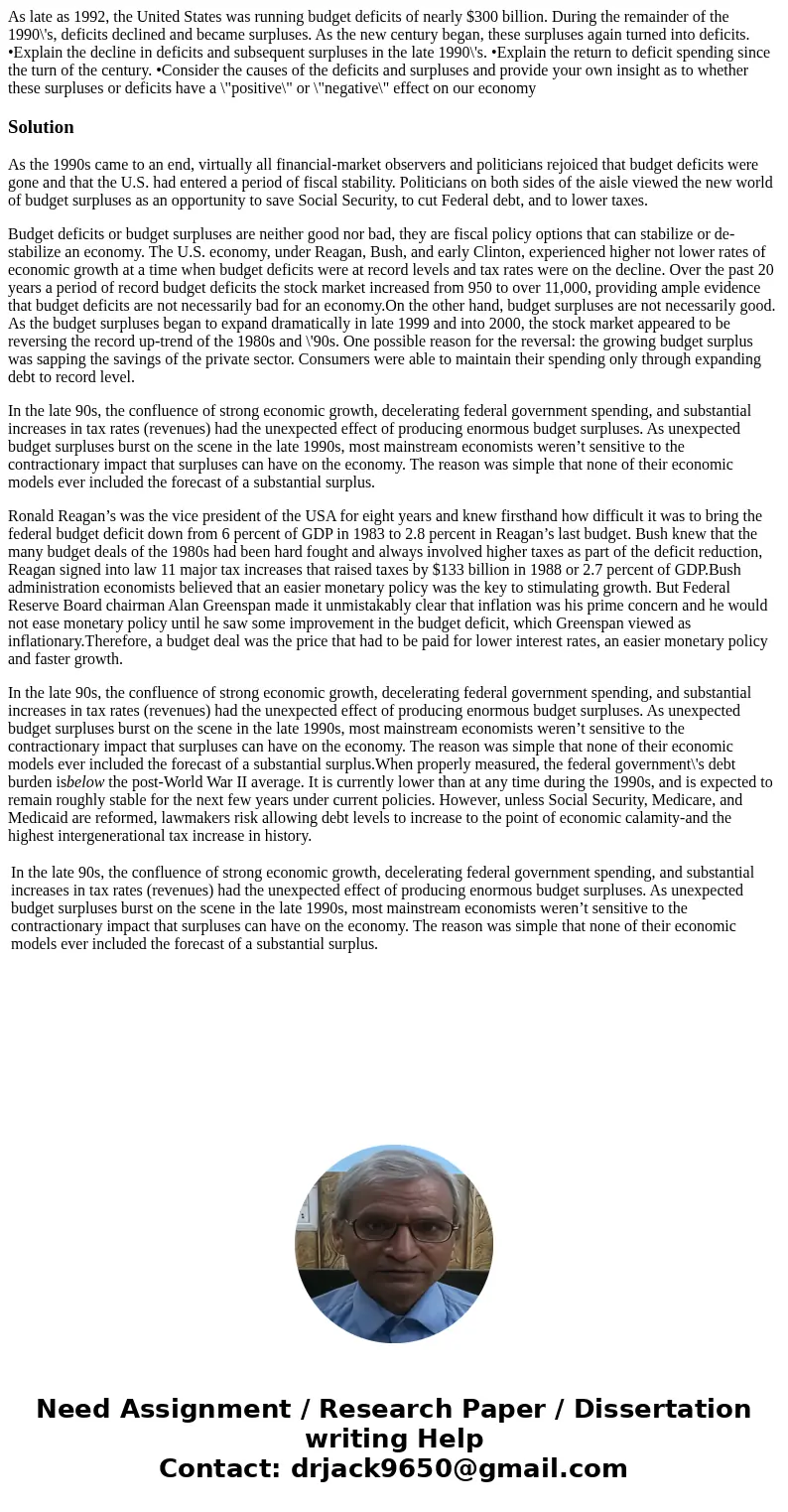As late as 1992 the United States was running budget deficit
As late as 1992, the United States was running budget deficits of nearly $300 billion. During the remainder of the 1990\'s, deficits declined and became surpluses. As the new century began, these surpluses again turned into deficits. •Explain the decline in deficits and subsequent surpluses in the late 1990\'s. •Explain the return to deficit spending since the turn of the century. •Consider the causes of the deficits and surpluses and provide your own insight as to whether these surpluses or deficits have a \"positive\" or \"negative\" effect on our economy
Solution
As the 1990s came to an end, virtually all financial-market observers and politicians rejoiced that budget deficits were gone and that the U.S. had entered a period of fiscal stability. Politicians on both sides of the aisle viewed the new world of budget surpluses as an opportunity to save Social Security, to cut Federal debt, and to lower taxes.
Budget deficits or budget surpluses are neither good nor bad, they are fiscal policy options that can stabilize or de-stabilize an economy. The U.S. economy, under Reagan, Bush, and early Clinton, experienced higher not lower rates of economic growth at a time when budget deficits were at record levels and tax rates were on the decline. Over the past 20 years a period of record budget deficits the stock market increased from 950 to over 11,000, providing ample evidence that budget deficits are not necessarily bad for an economy.On the other hand, budget surpluses are not necessarily good. As the budget surpluses began to expand dramatically in late 1999 and into 2000, the stock market appeared to be reversing the record up-trend of the 1980s and \'90s. One possible reason for the reversal: the growing budget surplus was sapping the savings of the private sector. Consumers were able to maintain their spending only through expanding debt to record level.
In the late 90s, the confluence of strong economic growth, decelerating federal government spending, and substantial increases in tax rates (revenues) had the unexpected effect of producing enormous budget surpluses. As unexpected budget surpluses burst on the scene in the late 1990s, most mainstream economists weren’t sensitive to the contractionary impact that surpluses can have on the economy. The reason was simple that none of their economic models ever included the forecast of a substantial surplus.
Ronald Reagan’s was the vice president of the USA for eight years and knew firsthand how difficult it was to bring the federal budget deficit down from 6 percent of GDP in 1983 to 2.8 percent in Reagan’s last budget. Bush knew that the many budget deals of the 1980s had been hard fought and always involved higher taxes as part of the deficit reduction, Reagan signed into law 11 major tax increases that raised taxes by $133 billion in 1988 or 2.7 percent of GDP.Bush administration economists believed that an easier monetary policy was the key to stimulating growth. But Federal Reserve Board chairman Alan Greenspan made it unmistakably clear that inflation was his prime concern and he would not ease monetary policy until he saw some improvement in the budget deficit, which Greenspan viewed as inflationary.Therefore, a budget deal was the price that had to be paid for lower interest rates, an easier monetary policy and faster growth.
In the late 90s, the confluence of strong economic growth, decelerating federal government spending, and substantial increases in tax rates (revenues) had the unexpected effect of producing enormous budget surpluses. As unexpected budget surpluses burst on the scene in the late 1990s, most mainstream economists weren’t sensitive to the contractionary impact that surpluses can have on the economy. The reason was simple that none of their economic models ever included the forecast of a substantial surplus.When properly measured, the federal government\'s debt burden isbelow the post-World War II average. It is currently lower than at any time during the 1990s, and is expected to remain roughly stable for the next few years under current policies. However, unless Social Security, Medicare, and Medicaid are reformed, lawmakers risk allowing debt levels to increase to the point of economic calamity-and the highest intergenerational tax increase in history.
| In the late 90s, the confluence of strong economic growth, decelerating federal government spending, and substantial increases in tax rates (revenues) had the unexpected effect of producing enormous budget surpluses. As unexpected budget surpluses burst on the scene in the late 1990s, most mainstream economists weren’t sensitive to the contractionary impact that surpluses can have on the economy. The reason was simple that none of their economic models ever included the forecast of a substantial surplus. |

 Homework Sourse
Homework Sourse